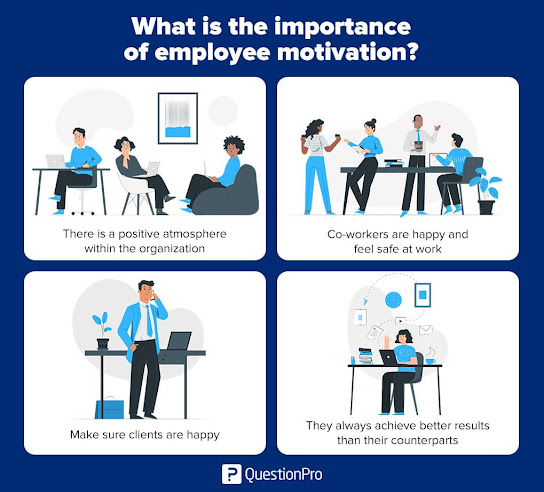IMPACT OF EMPLOYEE MOTIVATION IN ORGANIZATIONAL SUCCESS
Introduction
Motivation as a meaningful
construct is a central pillar at the workplace. Thus, motivating employees
adequately is a challenge as it has what it takes to define employee
satisfaction at the workplace (Forson.A.J, Dwamena.E.O, Opoku.R.A &
Adjavon.S.E, 2021). The Self-determination Theory (SDT) provides evidence that
suggests that motivation fuels performance (Deci EL, Olafsen AH, Ryan RM, 2017).
Definition of Employee Motivation
Campbell and Pritchard (1976,
p.78) defined motivation as determinants of the choice to initiate effort on
the given task the choice to expend a certain amount of effort, and the choice
to persist in expending effort over a period of time.”
“Motivation is a stimulant desire
and willingness to work in one's locomotion; it affects the arousal, direction,
and maintenance of behaviours relevant to the work setting” (Sari, Mulyani,
& Sari, 2019, p. 5).
Intrinsic & Extrinsic Motivation
When discussing employee
motivation, the most important two aspects of this term are the intrinsic and
extrinsic factors that impact employee motivation.
Intrinsic motivation
Intrinsic motivation means that
an individual is motivated from within. He/she has the desire to perform well
at the workplace because the results are in accordance with his/her belief
system.
An individual’s deep-rooted
beliefs are usually the strongest motivational factor. Such individuals show
common qualities like acceptance, curiosity, honor, and desire to achieve
success.
Research has shown that praise
increases intrinsic motivation, and so does positive employee feedback. So if
you are a manager, supervisor, or in a leadership role, please be intentional
with your feedback or praise. Make sure it is empowering and that your
employees understand your expectations.
Extrinsic motivation
Alternatively, extrinsic
motivation means an individual’s motivation is stimulated by external factors-
rewards and recognition. Therefore, some people may never be motivated
internally, and only external motivation would work with them to get the tasks
done.
Moreover, research says extrinsic
rewards can sometimes promote the willingness of a person to learn a new skill
set. Additionally, rewards like bonuses, perks, awards, etc., can motivate
people or provide tangible feedback.
The Relationship Between
Managers and Employees
According to Ritter Joseph and
Anker Richard (2002), the relationship between managers and their employees greatly
affects motivation. Managers are supposed to come up with strategies that will
ensure that employees remain motivated all the time. One related strategy is
formulating a plan where the employee can have live forums with their
supervisors and managers on a regular basis. Through those forums, managers are
also supposed to recognize the behavioral patterns of their employees. Every
employee has their own distinct behavior that cannot be compared to another.
By understanding and appreciating the behavioral patterns of their employees,
managers will be able to know which incentives and techniques to use to
motivate their employees.
Better communication between
managers and their employees is also another factor that strengthens the
relationship between them. Managers who rarely communicate with their employees
suffer a blow when it comes to the overall outcomes of the organization. Ritter
& Anker (2002) further point out that the closer the managers are to their
employees, the more motivated the latter become. Regular communication between
the two also makes managers understand the needs of each personal employee,
thus knowing which technique to use to motivate them. This generalization is
what leads to dismal performances in most organizations.
Employee motivation and job
performance
It’s a proven fact from the
studies that the motivated employees have higher engagement in work which result
in higher performance. The aggregated job motivation indicator when regressed
on job performance reveals a positive and significant effect (Forson.A.J,
Dwamena.E.O, Opoku.R.A & Adjavon.S.E, 2021).
Conclusion
The concept of “Employee
Motivation” is one of the most prominent domains of “Human Resource Management”
and is a continuing strategic element in all companies. Employee Motivation
plays a vital role in building enthusiasm inside employees which allows them to
work more and accomplish goals. Companies that can motivate their employees
well are capable of upholding a sound employee retention rate. Companies should
realize that the most vital capital in any establishment is the employees
themselves. It is not about the information nor the infrastructure; it is the
employees who have the brain and knowledge to run businesses and make them
profitable.
References
Forson.A.J, Dwamena.E.O, Opoku.R.A & Adjavon.S.E, 2021,
Employee motivation and job performance: a study of basic school teachers in
Ghana (Available at) https://fbj.springeropen.com/articles/10.1186/s43093-021-00077-6
(Accessed on May 2023)
Campbell and Pritchard, 1976, Motivation Theory in
Industrial and Organizational Phychology (Available at) http://web.mit.edu/curhan/www/docs/Articles/15341_Readings/Motivation/Campbell_&_Pritchard_Motivation_Theory_in_Handbook_Org_Psych.pdf
(Accessed on May 2023)
Mulyani S.R., Sari V.N., Sari M.W.2019, THE MODEL OF
EMPLOYEE MOTIVATION AND COOPERATIVE EMPLOYEE PERFORMANCE (Available at) https://yadda.icm.edu.pl/baztech/element/bwmeta1.element.baztech-aff983fb-7668-43fa-8739-e439103c14c7/c/pjms.2019.20.2.32_379--390.pdf
(Accessed on May 2023)
Deci EL, Olafsen AH, Ryan RM (2017) Self-determination
theory in work organizations (Available at) https://www.researchgate.net/profile/Edward-Deci/publication/312960448_Self-Determination_Theory_in_Work_Organizations_The_State_of_a_Science/links/58d98132aca272d801d50019/Self-Determination-Theory-in-Work-Organizations-The-State-of-a-Science.pdf
(Accessed on May 2023)
Ritter, J. & Anker, R. (2002). Good Jobs, Bad Jobs:
Workers’ Evaluations in Five Countries. International Labor Review, 141(4), 331
– 358 (Available at) https://www.researchgate.net/publication/227993743_Good_jobs_bad_jobs_Workers'_evaluations_in_five_countries
(Accessed on May 2023)
QuestionPro, Employee Motivation: The Complete Guide,
(Available at) https://www.questionpro.com/blog/employee-motivation/
(Accessed on May 2023)
Alsayyed.N & Sweis. R.J, 2019, The Effects of Training
and Motivating Employees on Improving Performance of Construction Companies The
Case of Jordan (Available at) https://www.researchgate.net/figure/Figure-2-Graphical-Illustration-of-Motivation-and-Job-Performance_fig2_333089038
(Accessed on May 2023)





Comments
Post a Comment